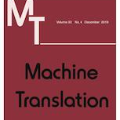Neural machine translation (NMT) systems are usually trained on a large amount of bilingual sentence pairs and translate one sentence at a time, ignoring inter-sentence information. This may make the translation of a sentence ambiguous or even inconsistent with the translations of neighboring sentences. In order to handle this issue, we propose an inter-sentence gate model that uses the same encoder to encode two adjacent sentences and controls the amount of information flowing from the preceding sentence to the translation of the current sentence with an inter-sentence gate. In this way, our proposed model can capture the connection between sentences and fuse recency from neighboring sentences into neural machine translation. On several NIST Chinese-English translation tasks, our experiments demonstrate that the proposed inter-sentence gate model achieves substantial improvements over the baseline.
翻译:神经机器翻译(NMT)系统通常在大量双语配对和一次翻译一个句子方面受过培训,忽略了判决间信息。 这可能使得判决的翻译模糊不清,甚至与邻近判决的翻译不一致。 为了处理这一问题,我们提议了一个判决间门模型,使用同一个编码来编码两个相邻的句子,控制从前一句到翻译当前句子的信息量,并设置一个判决间门。 这样,我们提议的模型可以捕捉从邻近判决到导体导体反应导体之间的连接。 在几项 NIST 中文-英文翻译任务中,我们的实验表明,拟议的判决间导门模型比基线大有改进。




